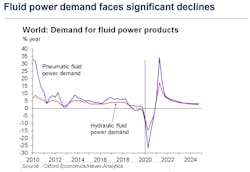Three days of intensive economic data presented as part of the National Fluid Power Association’s annual Industrial & Economic Outlook Conference on Aug. 11-13 came to two fundamental conclusions:
- The economy is on the road to recovery after a severe downturn following the COVID-19 pandemic;
- That projection is valid as long as nothing derails the recovery.
Economist Alan Beaulieu, who delivered the keynote at the virtual event on Aug. 11, sees a lot to like in the near-term economic trends, but also acknowledges there are a lot of concerns in a post-COVID world. His primary point is that barring a further shutdown of economies, the fundamentals of the U.S. economy remain sound.
“This was a shutdown instead of a breakdown,” Beaulieu, president of ITR Economics, told the NFPA attendees. Beaulieu’s presentation, and all of the three days of manufacturing and vertical market forecasts, are available through mid-October at nfpahub.com.
Because the economy was shocked into recession rather than reacting to specific economic policy failure, Beaulieu believes the recovery likely would be different than the 2008-09 Great Recession. The recovery could still take into early next year to get back to pre-pandemic levels, but he expects the recovery will gather steam throughout 2021.
The opportunity Beaulieu highlighted was for fluid power companies to catch the rebound on the upswing. “You’re going to be able to get your business further faster while other sit back and wait,” he said. “Sitting and waiting is not an option.”
Michael Reid, senior economist for Oxford Economics, underscored the severity of the decline on the fluid power industry in his presentation. “The overall demand for fluid power took quite a hit in 2020,” Reid said. “This pandemic is affecting all regions. No country is escaping this current crisis.”
Reid said it was important for suppliers and manufacturers to stay on top of changes in the market and be prepared to adapt as conditions change. “This is a significant and historic recession. You’re going to want to get forecasts on the most recent data, from economic data to health data,” Reid said. “A second wave of infections across a large number of countries could mean drastically lower growth next year.”
But should the gradual improvement continue, economists who spoke to the NFPA conference agree that a recovery would be gradual and continue throughout 2021. “Despite seeing rising cases and rising deaths, we don’t see a widescale shutdown coming,” said Alex Chausovsky, director of speaking services for ITR Economics. “As long as that doesn’t happen, the trajectory is going to happen as we expect and there will be a rise in business over 2021. We still have some downside pressure, but we’re starting to see some green shoots in the economy.”
One lesson from the Great Recession was that those businesses and industries that correctly anticipated the recovery were better prepared to take advantage of the accelerating economy. It’s a lesson worth repeating today, Chausovsky said.
“You have to be planning for the recovery, and for the future,” he said. “Ask yourself, ‘What do I wish I’d done more of in 2008-09?’ You should determine what kinds of moves to make now to take full advantages of that recovery when it comes. In the near term, manufacturing is posed for more pain, but in the longer term, we’re quite optimistic.”
Optimism for the fluid power sector is more tempered, however. “Year-over-year growth in fluid power continues to deteriorate. Shipments are down 25% over 2020,” Chausovsky said. “We do expect a bounce back of 10% next year, which won’t get you back to where you were, but is well on the road to recovery.”
One key area is a re-examination of supply chains and more local sourcing of materials and parts. “We believe companies are actively looking to develop alternative sourcing. We challenge you to look for those opportunities,” Chausovsky said. “The decades of the 2020s looks very positive for manufacturing in the U.S. Companies are looking for shorter lead times and a higher focus on quality control.
“Obviously it’s more expensive to source in North America,” he added, “but it is a price they are willing to pay for significant improvement in the resiliency of the supply chain.”
About the Author

Bob Vavra
Editor Emeritus, Machine Design and Power & Motion
Bob Vavra is the former senior content director of Machine Design and Power & Motion.

